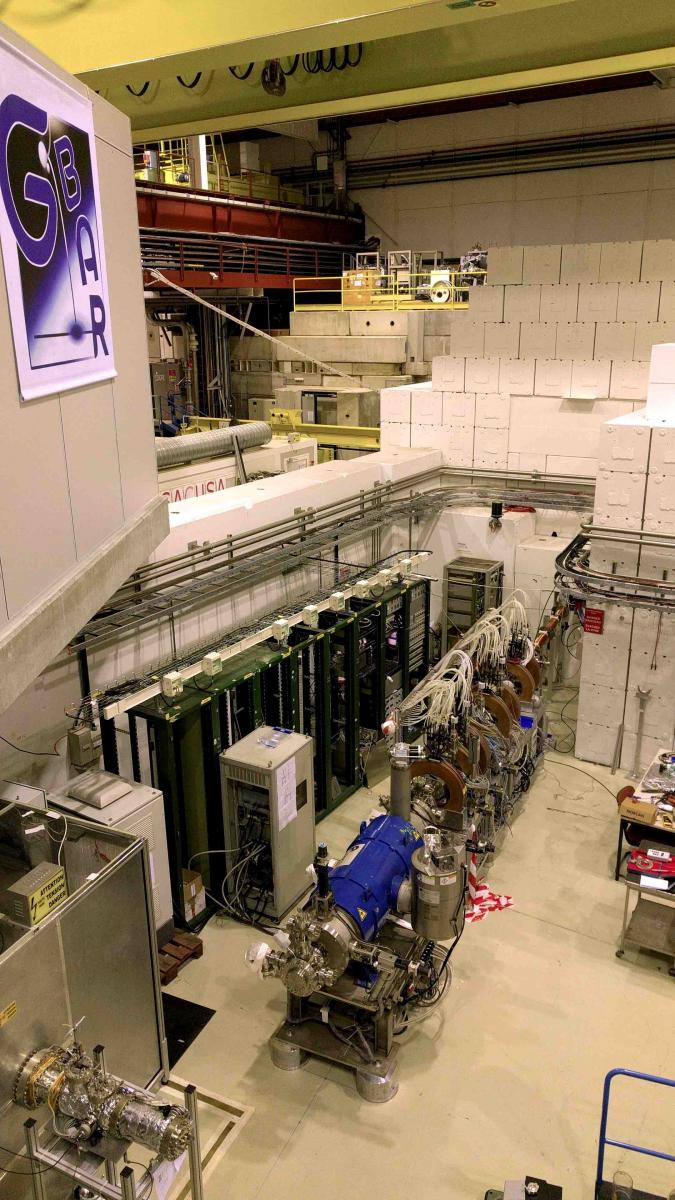First positrons for GBAR

At the CERN Antimatter Factory, antihydrogen atoms are produced routinely by merging antiprotons and positrons. In order to control this process, it is necessary to reduce the energy of those particles, i.e. decelerate them to the lowest possible energies. The antiprotons are generated by interactions of protons coming from the PS (Proton Synchrotron) with a metallic target. They are further decelerated in the AD (Antiproton Decelerator) to 5.3 MeV, to be followed by another deceleration step with ELENA (Extra Low ENergy Antiproton), which is a new deceleration ring being commissioned to reach 100 keV. The positrons are usually obtained from the decay of 22Na radioactive sources of high intensity. The GBAR experiment however requires a much higher positron intensity to produce not only antihydrogen atoms but also anti ions. This will be performed in a chain of two charge exchange reactions:
where Ps stands for positronium the bound pair of an electron and a positron. The required amount of positronium, hence of positrons, is of the order of 1010 per antiproton pulse.
The radioactive sources are limited in size in order to obtain a narrow beam and also in thickness since positrons could interact within the source itself. The half-life of those sources is 2.6 years. There is only one provider. Experiments dealing with slow positrons use also nuclear research reactors such as in Munich or Delft, or electron accelerators as was the case at Livermore. These would not fit in the AD hall though. We thus studied the possibility to use a small electron linear accelerator. There, positrons are produced by pair creation in the interaction of the electron beam with a high Z and dense target. The production rate increases with the energy of the electron beam. However, activation of the environment becomes huge when the energy of the beam exceeds 10 MeV and would prevent interventions by researchers. The positron rate is then lower at such energy compared to the energy of the accelerators used for particle physics. This can be compensated by a high intensity of the electron beam and is typically what is done with particle irradiators. We used a 5 MeV linac at CEA-Saclay in France to demonstrate successfully this scheme, obtaining a flux of 3 x 106 slow e+/s, i.e. already similar to the strongest radioactive sources.

Figure 1 GBAR positron beam line coming out of the radiation shield in the AD hall. The line is being equipped with Penning-Malmberg traps for accumulation of the positrons before interaction with the antiprotons.
The GBAR linac was built at the NCBJ laboratory in Swierk (Poland). Its first version was transported to CERN this year and is being commissioned at an energy of 9 MeV. The repetition rate can be varied between 1 and 300 Hz with a pulse length of 3 µs. The electron beam hits a tungsten target where gamma rays and positrons are produced with an average energy of the order of 1 MeV. The large amount of gamma rays and electrons requires an important radiation shield made of concrete and iron. It was made at CERN with refurbished LEP yokes and normal blocks totaling a mass of 1400 tons. The energy of the positrons is reduced to a few eV when they interact in a moderator made of tungsten meshes. Such low energy positrons, also called slow positrons, can then be easily transported to the experimental zone located outside the radiation shield that hosts the linac. At this point in the commissioning period, the electron intensity and energy is kept well below the regime foreseen for the experiment. However, we already could measure the positron flux at values that would reach 108 e+/s when extrapolated to the final energy and intensity. Caution must be met in such linear extrapolation since we do not know the true extrapolation curve. Indeed several effects can change the extrapolation such as heating of the moderator and creation of defects with irradiation. Answers are due in March 2018 with the final version of the linac to be installed then.
